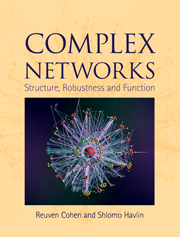Book contents
- Frontmatter
- Contents
- 1 Introduction
- PART I RANDOM NETWORK MODELS
- 2 The Erdős–Rényi models
- 3 Observations in real-world networks: the Internet, epidemics, proteins and DNA
- 4 Models for complex networks
- 5 Growing network models: the Barabási–Albert model and its variants
- PART II STRUCTURE AND ROBUSTNESS OF COMPLEX NETWORKS
- PART III NETWORK FUNCTION: DYNAMICS AND APPLICATIONS
- Appendix A Probability theoretical methods
- Appendix B Asymptotics and orders of magnitude
- Appendix C Algorithms for network simulation and investigation
- References
- Index
3 - Observations in real-world networks: the Internet, epidemics, proteins and DNA
from PART I - RANDOM NETWORK MODELS
Published online by Cambridge University Press: 05 August 2013
- Frontmatter
- Contents
- 1 Introduction
- PART I RANDOM NETWORK MODELS
- 2 The Erdős–Rényi models
- 3 Observations in real-world networks: the Internet, epidemics, proteins and DNA
- 4 Models for complex networks
- 5 Growing network models: the Barabási–Albert model and its variants
- PART II STRUCTURE AND ROBUSTNESS OF COMPLEX NETWORKS
- PART III NETWORK FUNCTION: DYNAMICS AND APPLICATIONS
- Appendix A Probability theoretical methods
- Appendix B Asymptotics and orders of magnitude
- Appendix C Algorithms for network simulation and investigation
- References
- Index
Summary
During the late 1990s, the advancement and popularity of computers (in particular PCs) changed our understanding of complex networks. The availability and power of computers made it possible to gather huge databases of network structures and to analyze them quickly and efficiently. This allowed, for the first time, the comparison of real network data with the existing models, and, in particular, the ER model. Another significant influence of the computing revolution was the creation of two huge and rapidly developing networks: the Internet and the World Wide Web (WWW).
Real-world complex networks
Below, we present a few examples of real-world networks, many of which are well approximated by a scale-free degree distribution. Many other examples that exist may be found in the recent literature (see e.g. [AB02, BBV08, BLM+06, DM03, New02b, PV03]).
Computer networks and the Internet
Computer networks are good candidates for studying the role they play in the Internet. The connections in this case are physical – a link exists between two nodes (computers) in the network if they are physically connected by a cable (usually copper or optical fiber, although some other connection types, such as satellites, exist). Various sizes of networks exist, ranging from a simple LAN (local area network) – where usually a small number of computers are all connected together – to wide area networks (WANs), which may consist of tens of thousands of computers.
- Type
- Chapter
- Information
- Complex NetworksStructure, Robustness and Function, pp. 16 - 30Publisher: Cambridge University PressPrint publication year: 2010
- 1
- Cited by



